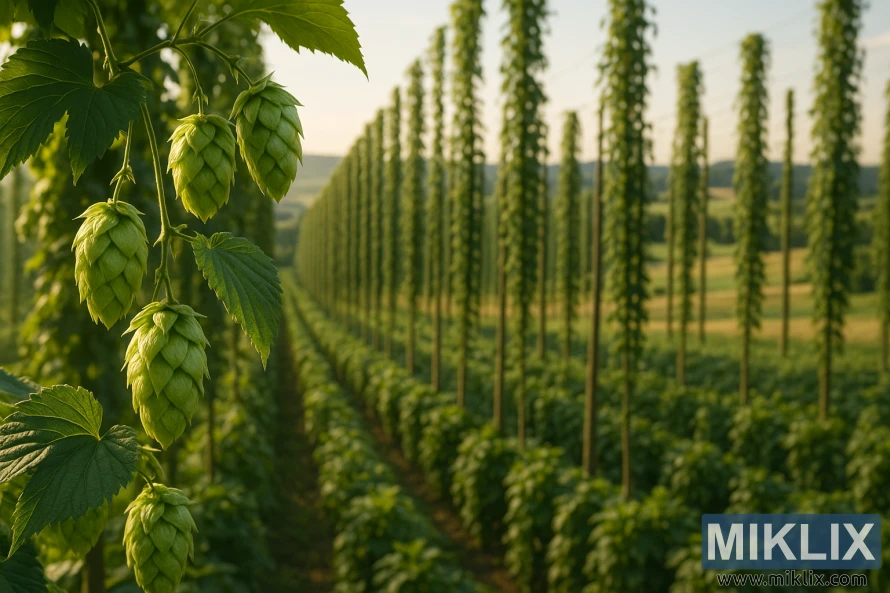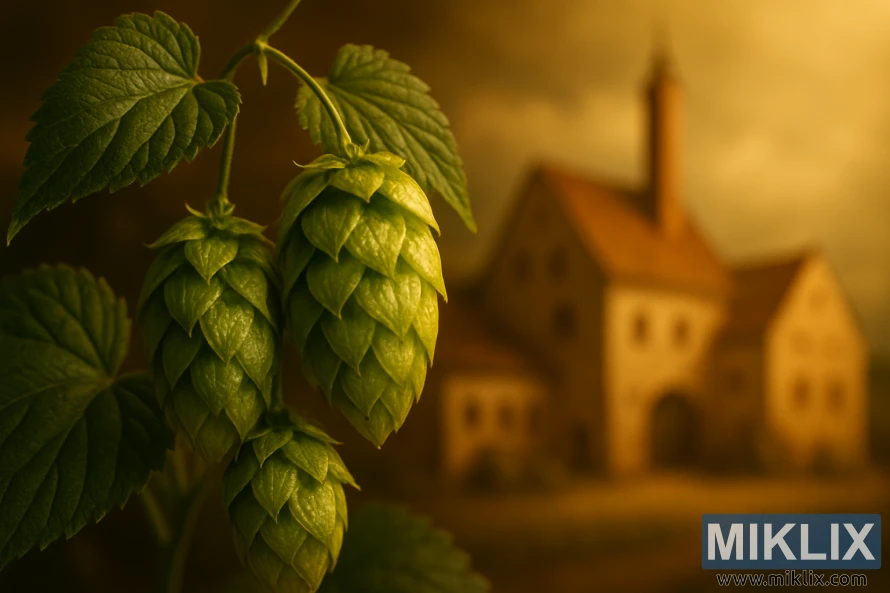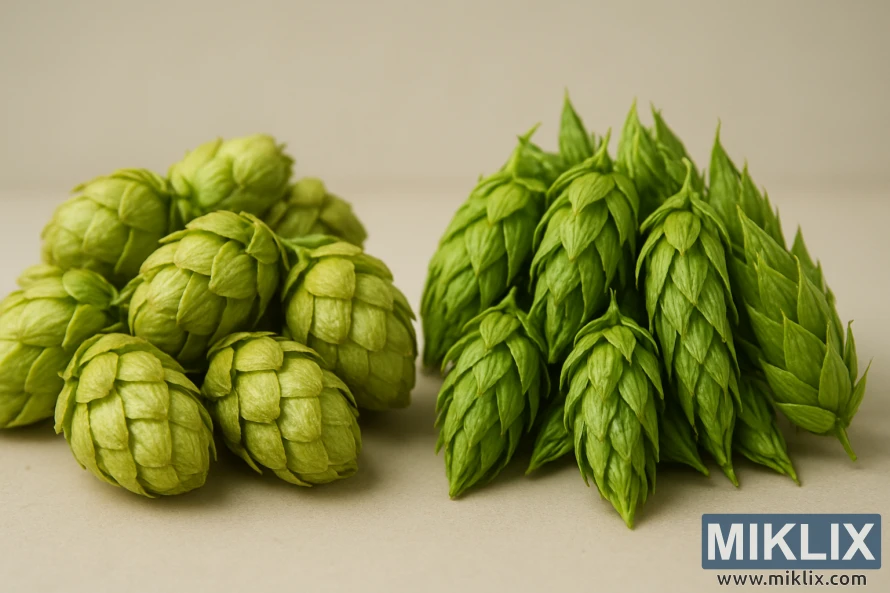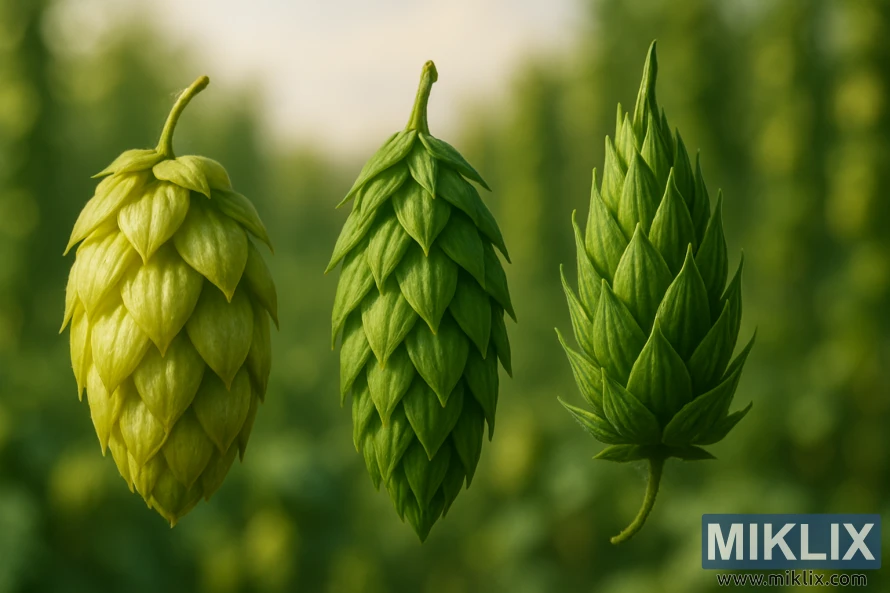Hops in Beer Brewing: Hallertau
Published: September 13, 2025 at 10:58:00 PM UTC
Hallertau hops are a renowned choice among brewers for their mild and pleasant flavor profile. They are ideal for various beer styles, but they shine in lagers. Originating from the Hallertau region in Germany, these noble hops have been a staple in traditional brewing for centuries. Their unique characteristics contribute to the complexity and depth of beer without overpowering it. Brewing with Hallertau hops allows for a delicate balance of flavors. This enhances the overall quality of the beer. This introduction sets the stage for understanding the significance of Hallertau hops in the brewing process.

Key Takeaways
- Noble hops like Hallertau are prized for their mild flavor.
- Hallertau hops are traditionally used in lager brewing.
- The use of Hallertau hops contributes to the complexity of beer.
- These hops are known for their pleasant flavor profile.
- Hallertau hops are a staple in traditional German brewing.
The Historical Legacy of Hallertau Hops
The history of Hallertau hops is a rich tapestry, woven over the past 400 years. Originating in Germany's Hallertau region, these hops have been a cornerstone in brewing for centuries. Their journey through time is a testament to the craft's enduring legacy.
Hallertau hops were celebrated for their unique flavor and aroma. These qualities made them a favorite among brewers. The region's fertile soil and climate created an ideal environment for hop cultivation. This led to Hallertau becoming synonymous with quality hops.
Today, Hallertau hops are a staple in German beer brewing, most famously in lagers. Their distinct characteristics, including a mild, slightly spicy flavor and aroma, make them perfect for traditional German beer styles. This is why they remain a favorite among brewers.
The importance of Hallertau hops goes beyond their flavor. They are considered "noble hops," a term reserved for the highest quality hops. Other renowned varieties, like Saaz, Spalt, and Tettnanger, also fall under this classification.
- Hallertau hops are known for their mild, slightly spicy flavor and aroma.
- They are a key ingredient in traditional German lagers.
- Their classification as "noble hops" highlights their quality and significance in brewing.
The historical legacy of Hallertau hops showcases the enduring importance of tradition in brewing. As the brewing industry evolves, Hallertau hops continue to be cherished by brewers globally.
Understanding Hallertau Hops Varieties
Hallertau hops come in various forms, from the classic Hallertauer Mittelfrüh to the newer Hallertauer Tradition. These types are essential for many beer styles. They provide brewers with a wide range of options for creating unique beers.
The Hallertauer Mittelfrüh is widely recognized for its mild and pleasant taste. It's often used in traditional German lagers and pilsners. Its subtle bitterness and aroma are highly sought after in these styles.
By contrast, Hallertauer Tradition offers a more robust flavor, with a spicy note that enriches different beer styles. This variety is celebrated for its adaptability and is used in a variety of brewing contexts.
Some key traits of Hallertau hops varieties include:
- Mild and pleasant flavor profiles, as seen in Hallertauer Mittelfrüh
- Robust and spicy flavor profiles, characteristic of Hallertauer Tradition
- Versatility in brewing applications, making them suitable for a wide range of beer styles
Breweries globally use these varieties to craft complex and balanced beers. By grasping the unique traits of each Hallertau hops variety, brewers can make better choices for their brewing projects.
In conclusion, the diverse Hallertau hops varieties give brewers a rich set of tools. They can use these to create a wide array of beer styles, from traditional lagers to innovative brews.
Essential Characteristics of Hallertau Hops
Hallertau hops are renowned for their mild and pleasant flavor. They are celebrated for their delicate aroma and flavor profile, often described as floral and herbal. This makes them a top choice for brewers aiming to add complexity to their beers.
The flavor of Hallertau hops is sweet and slightly spicy, with a fruity hint. This complexity enriches various beer styles, making Hallertau a versatile hop variety. The aroma is equally complex, featuring floral and herbal notes that elevate the beer-drinking experience.
- Mild and pleasant flavor
- Floral and herbal aroma notes
- Sweet and slightly spicy flavor profile
- Hint of fruitiness
These traits make Hallertau hops a favorite among brewers. By using Hallertau hops in their recipes, brewers can craft beers with unique and complex flavors.

Growing Conditions and Cultivation Methods
Hallertau hops flourish in environments with well-drained soil and a cool, temperate climate. The Hallertau region in Germany, famous for its hop cultivation, offers perfect conditions for these hops.
For Hallertau hop cultivation, soil quality is key. The ideal pH range is 6.0 to 7.0, facilitating optimal nutrient absorption. It's also vital to have well-drained soil to avoid waterlogged conditions that can cause root rot and diseases.
A cool, temperate climate is essential for Hallertau hops. They need moderate temperatures and sufficient rainfall during the growing season for healthy growth. The region's climate, with its mild summers and cold winters, is ideal for cultivating Hallertau hops.
Traditional cultivation methods are used for Hallertau hops. These include:
- Training the hop bines to climb up trellises or strings
- Regular pruning to promote healthy growth and maximize yield
- Irrigation management to ensure adequate moisture levels
- Pest and disease management to protect the crop
By understanding and replicating these conditions and methods, brewers and farmers can grow high-quality Hallertau hops. These hops add distinct flavor and aroma to various beer styles.
Harvesting and Processing Techniques
Hallertau hops are celebrated for their subtle flavor and aroma. These are preserved through meticulous harvesting and processing methods. The harvesting of Hallertau hops is a hand-picked process. This ensures the cones are picked at their peak ripeness.
The hand-picked cones undergo drying to remove excess moisture. This step is vital in preserving the hops' flavor and aroma. Drying prevents spoilage and maintains the hops' quality.
Following drying, the hops are processed into a form suitable for brewing. This can involve pelletizing, where the dried hops are compressed into pellets. Or, they may be baled and left in their whole cone form. Pelletizing offers easier storage and transportation. Whole cones, on the other hand, provide a more traditional brewing experience.
The choice between pelletized and whole cone Hallertau hops depends on the brewer's preference and the beer recipe's specific requirements. Regardless of the form, the careful harvesting and processing of Hallertau hops are essential. They deliver the desired flavor and aroma to the finished beer.
Understanding the techniques involved in harvesting and processing Hallertau hops enhances brewers' appreciation for the craftsmanship behind these exceptional hops. It highlights their role in creating high-quality beers.
The Role of Hallertau Hops in Beer Styles
Hallertau hops are essential in defining the taste of various beer styles, most prominently in lagers. They are a cornerstone in German lager brewing, key in crafting pilsners and bocks.
Their unique flavor and aroma enhance the clean, crisp taste of lagers. Hallertau hops' mild and pleasant taste make them perfect for brewers aiming at traditional German lager styles.
- Pilsners: Known for their crisp, refreshing taste, pilsners often feature Hallertau hops for added flavor and aroma.
- Bocks: A stronger, more robust lager style, bocks benefit from the subtle bitterness and flavor nuances of Hallertau hops.
- Traditional German Lagers: Many traditional German lager styles rely on Hallertau hops to achieve their characteristic flavor profiles.
Hallertau hops' versatility allows brewers to explore different beer styles while keeping the traditional German lager flavor profiles intact.

Brewing Applications and Timing
Hallertau hops are essential in the brewing process, serving multiple roles. They are used for bittering, flavor, and aroma, shaping the beer's character. This versatility makes them a favorite among brewers.
For bittering, Hallertau hops are added early in the boil. This step is critical for the alpha acids to isomerize, adding bitterness to the beer. The timing of these additions usually falls within the first 60 minutes of the boil.
For flavor and aroma, Hallertau hops are added later. They are often added in the last 15-30 minutes of the boil. This method helps preserve their delicate compounds. Dry-hopping, adding hops after fermentation, enhances the beer's aroma without increasing bitterness.
The timing of Hallertau hop additions is key. Adding them too early can lead to the loss of their subtle flavors and aromas. On the other hand, adding them too late might not fully utilize their bittering capabilities.
- Early boil additions for bittering
- Late boil additions for flavor
- Dry-hopping for aroma enhancement
Understanding the best timing for Hallertau hop additions is vital for brewers. It allows them to create beers with complex, balanced flavors. Whether for bittering, flavor, or aroma, Hallertau hops are essential for crafting high-quality beers that highlight their unique traits.
Flavor Contributions to Different Beer Types
Hallertau hops bring unique flavors to various beer types, making them essential in brewing. They are celebrated for enriching the taste of ales and lagers.
In ales, Hallertau hops introduce fruity and floral notes that complement the maltiness. Their alpha acids balance bitterness, while beta acids and essential oils create a complex aroma. This makes them a top choice for brewers aiming to craft distinct ales.
For lagers, Hallertau hops contribute to a crisp, clean taste typical of German lagers. Their subtle flavor and aroma enhance the beer's refreshment without dominating it. This is key in lager brewing, where a delicate flavor balance is vital.
The flavor Hallertau hops impart depends on the beer style and brewing techniques. For example, in pale ales, they add floral and spicy notes. In wheat beers, they bring a refreshing, fruity taste.
Key characteristics of Hallertau hops in different beers include:
- A balanced bitterness and aroma
- Fruity and floral notes in ales
- Crisp and clean taste in lagers
- Versatility in various beer styles
Understanding Hallertau hops' flavor contributions allows brewers to craft a wide range of beers. Whether it's an ale, lager, or another style, these hops are invaluable for improving flavor and aroma.
Comparing Hallertau to Other Noble Hops
The noble hop family, including Hallertau, Saaz, and Tettnanger, offers brewers a range of subtle yet distinct flavor profiles. Hallertau hops are renowned for their balanced alpha and beta acid content, making them versatile in brewing.
Hallertau, Saaz, and Tettnanger are often categorized together as noble hops, but they have distinct characteristics. Saaz hops are known for their spicy and earthy flavor, while Tettnanger hops are prized for their floral and herbal notes.
When comparing these hops, several factors come into play:
- Flavor Profile: Hallertau has a mild, slightly spicy flavor. Saaz is more pronounced with its spicy and earthy notes. Tettnanger offers a floral and herbal taste.
- Aroma: Hallertau provides a subtle aroma, whereas Saaz has a more distinct earthy and spicy aroma. Tettnanger's aroma is often described as floral.
- Usage in Brewing: Hallertau is versatile and used in a variety of beer styles. Saaz is traditionally used in Czech pilsners, and Tettnanger is often found in German lagers.
In conclusion, while Hallertau, Saaz, and Tettnanger share the noble hop classification, their differences in flavor, aroma, and usage make each unique. Understanding these differences is critical for brewers aiming to craft specific beer profiles.

Storage and Preservation Best Practices
Hallertau hops need careful handling and storage to keep their unique flavor and aroma. Proper storage is key to maintaining quality and extending shelf life.
To store Hallertau hops effectively, brewers should follow these guidelines:
- Store hops in a cool and dry place, away from direct light and moisture.
- Maintain a consistent storage temperature between 32°F and 40°F.
- Use airtight containers to prevent oxidation and spoilage.
Following these storage best practices ensures Hallertau hops retain their characteristic flavor and aroma. Proper storage not only preserves the hops but also enhances the overall quality of the beer.
Effective preservation of Hallertau hops involves more than just storage; it requires a holistic approach to handling these delicate ingredients. By understanding and implementing the best storage practices, brewers can maximize the fullness of Hallertau hops in their brewing processes.
Common Brewing Challenges and Solutions
Brewing with Hallertau hops presents several challenges. One major issue is hop variability and consistency. The flavor and aroma of Hallertau hops can change greatly. This is due to factors like growing conditions, harvesting techniques, and storage methods.
To tackle variability, brewers can employ a few strategies. Using a mix of Hallertau hops and other varieties can help achieve a consistent taste. This blending balances Hallertau's unique traits with the stability of other hops.
Another challenge is avoiding overpowering flavors or aromas from Hallertau hops. To solve this, brewers can adjust when they add hops during brewing. Adding Hallertau hops later in the boil or during dry-hopping can preserve their delicate flavors and aromas.
- Monitor and adjust hop quantities based on the specific batch characteristics.
- Experiment with different hop varieties to complement Hallertau hops.
- Optimize storage conditions to preserve the quality of Hallertau hops.
Pairing Hallertau with Other Hop Varieties
Blending Hallertau hops with other varieties can enhance beer's complexity and depth. Hallertau, with its European brewing roots, pairs well with various hops. This combination creates unique and intriguing flavors.
Pairing Hallertau with noble hops like Saaz and Tettnanger results in a balanced taste. Saaz's spicy and earthy notes complement Hallertau's mild, slightly spicy flavors. Tettnanger adds a subtle floral touch.
For a bolder flavor, combine Hallertau with robust hops like Cascade and Chinook. Cascade's citrus and floral notes brighten the beer. Chinook's piney and spicy traits deepen the brew's complexity.
Some popular hop pairings include:
- Hallertau + Saaz: A classic mix for a smooth, earthy taste.
- Hallertau + Cascade: Brings a citrusy twist to traditional European beers.
- Hallertau + Chinook: Adds a piney, robust character.
Exploring different hop pairings lets brewers innovate and create unique beers. By understanding Hallertau's characteristics and how it interacts with other hops, brewers can craft complex, balanced brews.

Commercial Brewing Success Stories
Hallertau hops have become a cornerstone in commercial brewing, leading to numerous success stories globally. Breweries worldwide value these hops for their distinct flavor and aroma. This makes them ideal for a variety of beer styles.
In the production of traditional German lagers and bocks, Hallertau hops shine. Their subtle spicy and floral notes are highly sought after. Renowned breweries like Weihenstephan and Paulaner have long relied on Hallertau hops to craft their iconic beers.
But Hallertau hops' versatility extends beyond traditional German beers. They are also used in ales and specialty beers, broadening breweries' offerings. This versatility has allowed breweries to experiment and innovate, expanding their product lines.
- Hallertau hops contribute to the complexity of beer flavors.
- They are prized for their aroma and bittering properties.
- Hallertau hops are used in both traditional and modern beer styles.
The success of breweries using Hallertau hops highlights the critical role of hop selection in brewing. As the demand for craft and specialty beers continues to rise, Hallertau hops will likely remain a key player in commercial brewing.
Sustainable Farming and Future Outlook
The future of Hallertau hops hinges on sustainable farming practices. These practices aim to balance yield with environmental care. The brewing industry's growth has highlighted the need to reduce hop farming's environmental impact.
Hallertau hop farmers are embracing sustainable methods like organic farming and integrated pest management (IPM). Organic farming eschews synthetic fertilizers and pesticides, fostering soil health and biodiversity. IPM, on the other hand, employs a holistic approach to pest management, aiming to minimize harm to beneficial organisms.
There's a notable trend towards local and regional hop production. This approach cuts down on transportation costs and emissions, boosting local economies. Growing hops near breweries ensures a fresher product and supports sustainable supply chains.
The future for Hallertau hops looks bright, with sustainability leading the way. Growing demand for eco-friendly hops is driven by environmentally aware consumers. Hallertau farmers and the brewing sector must innovate and adopt sustainable practices to preserve this iconic hop variety for the long haul.
Conclusion
Hallertau hops are a treasured ingredient in beer brewing, known for their unique and versatile flavor. They bring a mild and pleasant taste to a variety of beer styles. This makes them a favorite among brewers.
Their rich history, diverse varieties, and sustainable farming practices support their use in brewing. As brewers seek out new and innovative styles, Hallertau hops remain a top choice.
Understanding Hallertau hops' characteristics, growing conditions, and brewing applications is key. This knowledge allows brewers to fully utilize this exceptional hop variety. Whether you're an experienced brewer or just starting, Hallertau hops are a great choice for your next project.
Further Reading
If you enjoyed this post, you may also like these suggestions:
